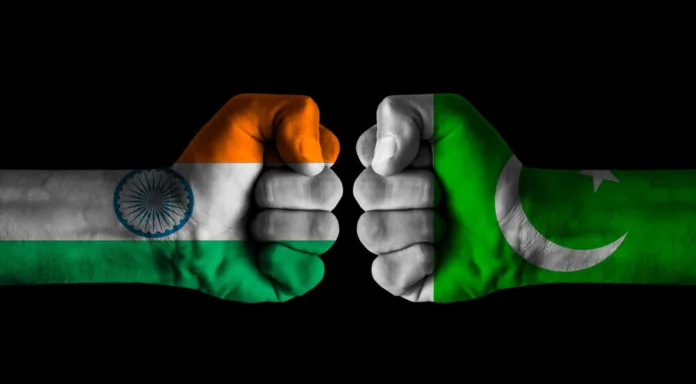✍ Dr. Khuram Iqbal
The threat of a devastating showdown between two nuclear armed states of South Asia has finally subsided, thanks to third party mediation led primarily by the US and complimented by Saudi Arabia and UAE. As has been the case in the past, peace brokered by third party has helped restoring the status-quo, a meaningful engagement remains a distant dream. Saffronization of Indian policy apparatus under Prime Minister Modi’s three consecutive terms has shrunk the space for substantive engagement between the two countries. It is, therefore, matter of time before the ceasefire agreement is violated by New Delhi on false pretext of terrorism. So shallow is the appeal of this narrative that not a single country backed Indian position accusing Pakistan for Pehalgam attack.
It is widely believed in the policy-making circles of Islamabad that peace with Pakistan is anti-thesis to BJP’s ultra-nationalist ideology, therefore, no breakthrough is expected due to this ideological aversion. The last three electoral campaigns by the BJP have made it clear that anti-Pakistan mantra is integral to the party’s ideology and any sincere efforts to mend fences with Islamabad can cost BJP local support among the hardline ultra-nationalists. Therefore, BJP may not have any political or economic incentive to normalize relations with Pakistan.
International policy and media discourse on South Asia often fails to capture or even register the existence of an ultra-nationalist government, which claims political mileage from every crises that involves Pakistan. Instead, Pakistan’s military establishment is generally criticized and presented as the “spoiler” seeking to justify its outsized role in politics and economy through “orchestrating” hostility with India. Such an assessment overlooks the policy shifts—and subsequent reversals—that have marked Pakistan Army’s approach toward India during last two decades.
Back in 2016, prospects of development afforded by China-Pakistan Economic Corridor (CPEC) had triggered a genuine reconsideration of India policy in Pakistan’s military establishment as well. But India was unwilling to capitalize on this historic opportunity. Former Army Chief of Pakistan General Qamar Javed Bajwa on many occasions publically invited India to bury the past and focus on a holistic dialogue and regional geo-economics. The military leadership back then even went on to invite India to join China Pakistan Economic Corridor (CPEC) to share the fruits of regional connectivity. New Delhi, however, invoked the disputed nature of CPEC passing through the disputed region of Kashmir.
The outright dismissal of General Bajwa’s peace overtures reinforced the perception that the BJP-led Indian government is fundamentally opposed to reconciliation with Pakistan. This persistent resistance to dialogue and confidence-building measures created a strong impression within Pakistan’s strategic circles that diplomatic efforts would be futile because Saffronization of India is now complete and irreversible. Consequently, Bajwa’s successor, the current Army Chief, saw little incentive to continue pursuing a conciliatory approach and instead reverted to a more traditional, hardline stance on India, aligning with the long-established military posture that views India as a persistent security threat.
The sequence of events mentioned above, brought much needed clarity to Pakistan’s civil and military leadership during the recent standoff. A bipartisan consensus existed that the country is up against an adversary that seeks to redraw South Asia in line with the idea of “Akhand Bharat” (Greater Bharat), where strategic decision-making resides with a cabinet, whose one third members are products of RSS, a Hindu supremacist organization banned in India thrice for its involvement in terrorism, most notably the assassination of the country’s founding father M.K Gandhi. Therefore, Islamabad took no chances. The decision to name the military operation “Operation Bunyan Marsoos” (Arabic for “a structure made of lead”) after a Quranic verse was intended to signal that if India was pursuing a civilizational conflict, Pakistan is prepared to respond in kind
Now that ceasefire is officially endorsed by both the countries, things are nowhere close to normal. Modi’s Pakistan rhetoric is no less-confrontational. In his first public speech on 12 May, Indian Prime Minister stated “India’s stand is absolutely clear -Water and blood cannot flow together”. Indian government still insists on holding Indus Water Treaty in abeyance, something that threatens Pakistan’s survival. As a lower riparian Pakistan depends on water originating from disputed region of Kashmir. Therefore, Islamabad had made it clear in 2016 that such a move by India will be considered as an act of war. Although, experts argue that India can’t hold back massive river volumes in peak flow due to limited infrastructure, flow control during dry seasons could still seriously hurt Pakistan.
Given its critical humanitarian and ecological importance, water is rarely employed as an instrument of war. If the situation has deteriorated to the point where such a measure is taken, it calls for serious scrutiny of the strategic thinking emerging from New Delhi. This shift reflects an aggressive ideological transformation of Indian security calculus. The ceasefire is not likely to result in any substantive development on Kashmir dispute and India’s overall policy towards Pakistan
*Dr. Khuram Iqbal is Associate Professor of Security Studies at the Department of International Relations, National Defense University of Pakistan
